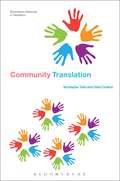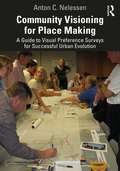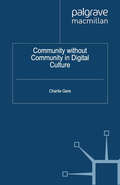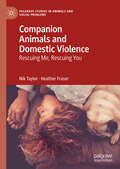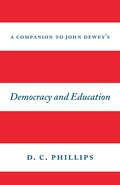- Table View
- List View
Community Sport Coaching: Policies and Practice
by Ben Ives Paul Potrac Laura Gale Lee NelsonIn many Western nations, community sport coaches occupy a central role in supporting the physical health, mental wellbeing, and wider social development of individuals and communities. However, there is no existing academic textbook that examines the policy contexts in which their work is located or, indeed, the challenges and opportunities that are an inherent feature of their everyday practice. Bringing together an international team of leading researchers in sport policy, sport development, sport pedagogy, and sport coaching, as well as some of the best emerging talents, this book is the first to critically consider a range of policy and practice issues directly connected to community sport coaching. Comprehensive, timely, and cutting-edge, no other text brings together in one place such a depth and breadth of scholarly material addressing this important field of endeavour. This book is an essential resource for educators, students, practitioners, and policy makers concerned with community sport coaching globally.
Community Strategic Visioning Programs (Non-ser.)
by Norman WalzerCommunity visioning and strategic planning programs have become increasingly important in recent years as local governments in rural areas have searched for innovative ways to revitalize their local economies or manage population growth. A panel of experts describes local government programs in ten states. They also evaluate the effectiveness in reaching the vision and objective set forth in these programs. The authors examine the main components of each program and offer insights into factors contributing to its success. Major attention is paid to the need for social capital, benchmarking, and continuing support following the initial efforts. The discussion in the book includes recommendations for starting a community strategic visioning exercise.
Community Studies: An Introduction to the Sociology of the Local Community (Studies in Sociology)
by Colin Bell Howard NewbyOriginally published in 1971, this was the first text on community studies which analysed the major empirical work in this field in a comparative perspective. It is concerned both with the sociology of community and the sociology of community studies. It takes both the findings of individual studies and the research process itself as significant sociological data in their own right, and it asks continually: how do we know what we know about communities? Community Studies is, then, not only a contribution to that particular field but also to our understanding of the interaction between theory and method in sociology. Studies are analysed from North and Latin America, Britain and Western Europe, and India. Two central problems, stratification and power, are considered at greater length. This book would prove to be an invaluable introduction not only for students of sociology but also for architects, planners and all those who had an interest in the community at the time. Its authors were, and had been, actively engaged in field research in this area.
Community Studies: An Introduction to the Sociology of the Local Community (Studies in Sociology)
by Colin Bell Howard NewbyOriginally published in 1971, this was the first text on community studies which analysed the major empirical work in this field in a comparative perspective. It is concerned both with the sociology of community and the sociology of community studies. It takes both the findings of individual studies and the research process itself as significant sociological data in their own right, and it asks continually: how do we know what we know about communities? Community Studies is, then, not only a contribution to that particular field but also to our understanding of the interaction between theory and method in sociology. Studies are analysed from North and Latin America, Britain and Western Europe, and India. Two central problems, stratification and power, are considered at greater length. This book would prove to be an invaluable introduction not only for students of sociology but also for architects, planners and all those who had an interest in the community at the time. Its authors were, and had been, actively engaged in field research in this area.
Community Translation (Bloomsbury Advances in Translation)
by Mustapha Taibi Uldis OzolinsInvestigating an important field within translation studies, Community Translation addresses the specific context, characteristics and needs of translation in and for communities. Traditional classifications in the fields of discourse and genre are of limited use to the field of translation studies, as they overlook the social functions of translation. Instead, this book argues for a classification that cuts across traditional lines, based on the social dimensions of translation and the relationships between text producers and audiences.Community Translation discusses the different types of texts produced by public authorities, services and individuals for communities that need to be translated into minority languages, and the socio-cultural issues that surround them. In this way, this book demonstrates the vital role that community translation plays in ensuring communication with all citizens and in the empowerment of minority language speakers by giving them access to information, enabling them to participate fully in society.
Community Translation (Bloomsbury Advances in Translation #2)
by Mustapha Taibi Uldis OzolinsInvestigating an important field within translation studies, Community Translation addresses the specific context, characteristics and needs of translation in and for communities. Traditional classifications in the fields of discourse and genre are of limited use to the field of translation studies, as they overlook the social functions of translation. Instead, this book argues for a classification that cuts across traditional lines, based on the social dimensions of translation and the relationships between text producers and audiences.Community Translation discusses the different types of texts produced by public authorities, services and individuals for communities that need to be translated into minority languages, and the socio-cultural issues that surround them. In this way, this book demonstrates the vital role that community translation plays in ensuring communication with all citizens and in the empowerment of minority language speakers by giving them access to information, enabling them to participate fully in society.
Community Unionism: A Comparative Analysis of Concepts and Contexts
by I. Greenwood J McBrideThis book examines the concept of 'community unionism', which argues that the future of the labour movement and industrial relations lies with the community and local labour markets. Providing a conceptual overview of the term, the book uses international case studies and draws on faith-based organizations to explore the issue.
Community Visioning for Place Making: A Guide to Visual Preference Surveys for Successful Urban Evolution
by Anton C. NelessenCommunity Visioning for Place Making is a groundbreaking guide to engaging with communities in order to design better public spaces. It provides a toolkit to encourage and assist organizations, municipalities, and neighborhoods in organizing visually based community participation workshops, used to evaluate their existing community and translate images into plans that embody their ideal characteristics of places and spaces. The book is based on results generated from hundreds of public participation visioning sessions in a broad range of cities and regions, portraying images of what people liked and disliked. These community visioning sessions have been instrumental in generating policies, physical plans, recommendations, and codes for adoption and implementation in a range of urban, suburban, and rural spaces, and the book serves as a bottom-up tool for designers and public officials to make decisions that make their communities more appealing. The book will appeal to community and neighborhood organizations, professional planners, social and psychological professionals, policy analysts, architects, urban designers, engineers, and municipal officials seeking an alternative vision for their future.
Community Visioning for Place Making: A Guide to Visual Preference Surveys for Successful Urban Evolution
by Anton C. NelessenCommunity Visioning for Place Making is a groundbreaking guide to engaging with communities in order to design better public spaces. It provides a toolkit to encourage and assist organizations, municipalities, and neighborhoods in organizing visually based community participation workshops, used to evaluate their existing community and translate images into plans that embody their ideal characteristics of places and spaces. The book is based on results generated from hundreds of public participation visioning sessions in a broad range of cities and regions, portraying images of what people liked and disliked. These community visioning sessions have been instrumental in generating policies, physical plans, recommendations, and codes for adoption and implementation in a range of urban, suburban, and rural spaces, and the book serves as a bottom-up tool for designers and public officials to make decisions that make their communities more appealing. The book will appeal to community and neighborhood organizations, professional planners, social and psychological professionals, policy analysts, architects, urban designers, engineers, and municipal officials seeking an alternative vision for their future.
Community Wayfinding: Pathways to Understanding
by Rebecca H. Hunter Lynda A. Anderson Basia L. BelzaThis book examines wayfinding from a broad public health perspective and articulates what needs to be done to create better wayfinding for all people regardless of age, ability, or mode of transportation. Addressing both science and the human experience, the book brings together a group of international experts to examine community wayfinding from a variety of viewpoints. It first presents a critical foundation for understanding wayfinding from an individual perspective. Next, it describes relevant design principles and practices by drawing upon architecture, environmental graphic design, universal design (UD), and urban planning. The book then goes on to examine wayfinding tools and innovative technologies ranging from maps to apps to complex systems. In addition, coverage includes case studies, lessons from wayfinding improvement initiatives, and recommendations for future research, practice, and policy. Overall, the book focuses on the economic and commercial benefits of good wayfinding, its potential impact on the health of individuals and communities, as well as strategies for the journey ahead. It will appeal to numerous professionals across many disciplines from architecture and cartography to public health and urban planning. Additionally, the book can help advance a dialogue among those interested in enhancing the livability of their communities.
Community Well-Being and Community Development: Conceptions and Applications (SpringerBriefs in Well-Being and Quality of Life Research #0)
by Seung Jong Lee Yunji Kim Rhonda PhillipsThis briefs provides foundations of both community wellbeing and community development, and the relationships between the two areas, including both similarities and differences. Community well-being encompasses a large array of concepts and disciplines. Community development, as an established discipline, is one framework that can help further understanding of community well-being, and is an allied concept. The interaction between the two areas is worthy of exploration, as both a new way to think about community development as well as a way to understand what community well-being entails. Beginning with a discussion of the foundations, the first and second chapters provide grounding for conceptions and potential theory applications as well as constructs for moving community wellbeing forward. The remaining chapters provide applications of community well-being in the context of community development, with examples from North America and Asia. Community development focused community wellbeing policies and programs illustrate processes and outcomes.
Community without Community in Digital Culture
by C. GereCommunity Without Community in Digital Culture presents the view that our digital culture is determined not by greater connection, but by the separation and gap that is a necessary concomitant of our fundamental technicity.
Community Work: Theory into Practice
by Karen McArdle Sue Briggs Kirsty Forrester Ed GarrettWritten by community workers from diverse contexts, this highly accessible guide equips practitioners and students working in a range of community settings to make the best use of theory in their work. The book focuses on the hope, excitement and possibilities that contemporary theory brings to practice and is essential reading for all those concerned with social justice, inclusion and equality. Drawing on voices from across the world, influential thinking, both old and new, is applied to the practice that underpins work with individuals, groups and communities. The book will inform and enhance practice for a wide range of students and professionals working in community contexts such as community development, adult education, youth work, community health and social work.
Community Work: Theory into Practice
by Karen McArdle Sue Briggs Kirsty Forrester Ed GarrettWritten by community workers from diverse contexts, this highly accessible guide equips practitioners and students working in a range of community settings to make the best use of theory in their work. The book focuses on the hope, excitement and possibilities that contemporary theory brings to practice and is essential reading for all those concerned with social justice, inclusion and equality. Drawing on voices from across the world, influential thinking, both old and new, is applied to the practice that underpins work with individuals, groups and communities. The book will inform and enhance practice for a wide range of students and professionals working in community contexts such as community development, adult education, youth work, community health and social work.
Commuter Spouses: New Families in a Changing World
by Danielle LindemannWhat can we learn from looking at married partners who live apart? In Commuter Spouses, Danielle Lindemann explores how couples cope when they live apart to meet the demands of their dual professional careers. Based on the personal stories of almost one-hundred commuter spouses, Lindemann shows how these atypical relationships embody (and sometimes disrupt!) gendered constructions of marriage in the United States. These narratives of couples who physically separate to maintain their professional lives reveal the ways in which traditional dynamics within a marriage are highlighted even as they are turned on their heads. Commuter Spouses follows the journeys of these couples as they adapt to change and shed light on the durability of some cultural ideals, all while working to maintain intimacy in a non-normative relationship.Lindemann suggests that everything we know about marriage, and relationships in general, promotes the idea that couples are focusing more and more on their individual and personal betterment and less on their marriage. Commuter spouses, she argues, might be expected to exemplify in an extreme manner that kind of self-prioritization. Yet, as this book details, commuter spouses actually maintain a strong commitment to their marriage. These partners illustrate the stickiness of traditional marriage ideals while simultaneously subverting expectations.
Compact Cities and Sustainable Urban Development: A Critical Assessment of Policies and Plans from an International Perspective
by Gert De Roo Donald MillerThis title was first published in 2000. Encouraging, even requiring, higher density urban development is a major policy in the European Community and of Agenda 21, and a central principle of growth management programmes used by cities around the world. This work takes a critical look at a number of claims made by proponents of this initiative, seeking to answer whether indeed this strategy controls the spread of urban suburbs into open lands, is acceptable to residents, reduces trip lengths and encourages use of public transit, improves efficiency in providing urban infrastructure and services, and results in environmental improvements supporting higher quality of life in cities.
Compact Cities and Sustainable Urban Development: A Critical Assessment of Policies and Plans from an International Perspective
by Gert De Roo Donald MillerThis title was first published in 2000. Encouraging, even requiring, higher density urban development is a major policy in the European Community and of Agenda 21, and a central principle of growth management programmes used by cities around the world. This work takes a critical look at a number of claims made by proponents of this initiative, seeking to answer whether indeed this strategy controls the spread of urban suburbs into open lands, is acceptable to residents, reduces trip lengths and encourages use of public transit, improves efficiency in providing urban infrastructure and services, and results in environmental improvements supporting higher quality of life in cities.
A Compact for Higher Education (Routledge Revivals)
by K. Moti Gokulsing Cornel DaCostaThis title was first published in 2000. This is a collection of papers which look at the relationship between higher education and those who use it, and those who will in the future. The papers look at how compacts could be developed to encourage the potential for maintaining and improving upon existing education agreements. The book covers the university and higher education institutions and their relationship with government and industry as well as with the students.
A Compact for Higher Education (Routledge Revivals)
by K. MOTI GOKULSING AND CORNEL DaCOSTAThis title was first published in 2000. This is a collection of papers which look at the relationship between higher education and those who use it, and those who will in the future. The papers look at how compacts could be developed to encourage the potential for maintaining and improving upon existing education agreements. The book covers the university and higher education institutions and their relationship with government and industry as well as with the students.
Companion Animals and Domestic Violence: Rescuing Me, Rescuing You (Palgrave Studies in Animals and Social Problems)
by Nik Taylor Heather FraserIn this book, Nik Taylor and Heather Fraser consider how we might better understand human-animal companionship in the context of domestic violence. The authors advocate an intersectional feminist understanding, drawing on a variety of data from numerous projects they have conducted with people, about their companion animals and links between domestic violence and animal abuse, arguing for a new understanding that enables animals to be constituted as victims of domestic violence in their own right. The chapters analyse the mutual, loving connections that can be formed across species, and in households where there is domestic violence. Companion Animals and Domestic Violence also speaks to the potentially soothing, healing and recovery oriented aspects of human-companion animal relationships before, during and after the violence, and will be of interest to various academic disciplines including social work, anthropology, sociology, philosophy, geography, as well as to professionals working in domestic violence or animal welfare service provision.
A Companion of Feminisms for Digital Design and Spherology
by Amanda WindleThis book questions if spherology is a philosophy for designers, giving guidance on ways to read Spheres, how to approach the trilogy’s indexicality, and apply the key tropes and ethics of atmospheres to digital design. Each chapter includes a design-in, that is a practical entry point into the many tropes of Spheres including— bubbles, globes and foam. The book also applies spherology to an atmosphere design issue involving endangered species and geospatial threats to the environment.Spherology refers to the Spheres trilogy by the philosopher Peter Sloterdijk, which traces spherical ideas, theories, sensations and feelings related to the philosophical concept of ‘being’ and the human-centered position of ‘being-in’. It is the first cynical, feminist companion of spherology to take a practice-led approach and to cover all three controversial volumes to with and against Spheres. Windle draws on feminist science and technology studies (STS) through parody within reading, writing and design practices. Design provides navigation so that academics and students can engage with spherology through an embodied concern with digital materiality.As a feminist companion for today’s design issues, the book is an essential read for feminist STS scholars, design practitioners and digital R&D specialists working both in industry and academia, including more specifically data visualisers, interface and interaction designers.
A Companion to Economic Forecasting (Blackwell Companions to Contemporary Economics)
by Michael P. Clements David F. HendryA Companion to Economic Forecasting provides an accessible and comprehensive account of recent developments in economic forecasting. Each of the chapters has been specially written by an expert in the field, bringing together in a single volume a range of contrasting approaches and views. Uniquely surveying forecasting in a single volume, the Companion provides a comprehensive account of the leading approaches and modeling strategies that are routinely employed.
Companion to European Heritage Revivals
by Linde Egberts Koos BosmaAre you organising an international heritage project? Turning a so-called 'heritage revival' into a meaningful experience for the general public can be a challenge to historians, archaeologists, museum conservators and tourism professionals alike. This Companion to European Heritage Revivals offers inspiration and new ideas to those who want to engage a large, international audience in activities which bring the past to life. It offers a critical examination of the field’s basic concepts and discusses a vast array of 'heritage revival tools', including games, historical re-enactments, 3D-visualisations, films, television documentaries, spatial designs and most importantly, international heritage routes. Through many case studies, this book demonstrates how various aspects of heritage can be effectively presented by linking historical places and landscapes in a single revival to create a multifaceted but coherent whole. Above all, it shows the exceptional success achieved by projects which consistently focus on creating meaningful experiences together with individual users.
A Companion to John Dewey's "Democracy and Education"
by D. C. PhillipsThis year marks the centenary publication of John Dewey’s magnum opus, Democracy and Education. Despite its profound importance as a foundational text in education, it is notoriously difficult and—dare we say it—a little dry. In this charming and often funny companion, noted philosopher of education D. C. Phillips goes chapter by chapter to bring Dewey to a twenty-first-century audience. Drawing on over fifty years of thinking about this book—and on his own experiences as an educator—he lends it renewed clarity and a personal touch that proves its lasting importance. Phillips bridges several critical pitfalls of Democracy and Education that often prevent contemporary readers from fully understanding it. Where Dewey sorely needs a detailed example to illustrate a point—and the times are many—Phillips steps in, presenting cases from his own classroom experiences. Where Dewey casually refers to the works of people like Hegel, Herbart, and Locke—common knowledge, apparently, in 1916—Phillips fills in the necessary background. And where Dewey gets convoluted or is even flat-out wrong, Phillips does what few other scholars would do: he takes Dewey to task. The result is a lively accompaniment that helps us celebrate and be enriched by some of the most important ideas ever offered in education.
A Companion to John Dewey's "Democracy and Education"
by D. C. PhillipsThis year marks the centenary publication of John Dewey’s magnum opus, Democracy and Education. Despite its profound importance as a foundational text in education, it is notoriously difficult and—dare we say it—a little dry. In this charming and often funny companion, noted philosopher of education D. C. Phillips goes chapter by chapter to bring Dewey to a twenty-first-century audience. Drawing on over fifty years of thinking about this book—and on his own experiences as an educator—he lends it renewed clarity and a personal touch that proves its lasting importance. Phillips bridges several critical pitfalls of Democracy and Education that often prevent contemporary readers from fully understanding it. Where Dewey sorely needs a detailed example to illustrate a point—and the times are many—Phillips steps in, presenting cases from his own classroom experiences. Where Dewey casually refers to the works of people like Hegel, Herbart, and Locke—common knowledge, apparently, in 1916—Phillips fills in the necessary background. And where Dewey gets convoluted or is even flat-out wrong, Phillips does what few other scholars would do: he takes Dewey to task. The result is a lively accompaniment that helps us celebrate and be enriched by some of the most important ideas ever offered in education.



